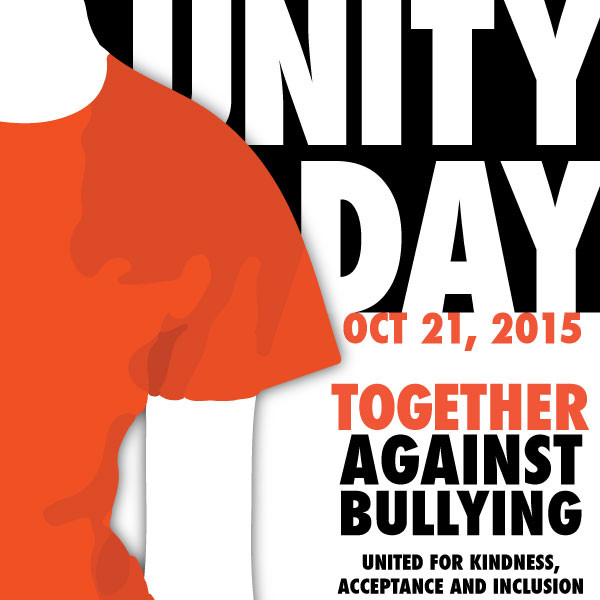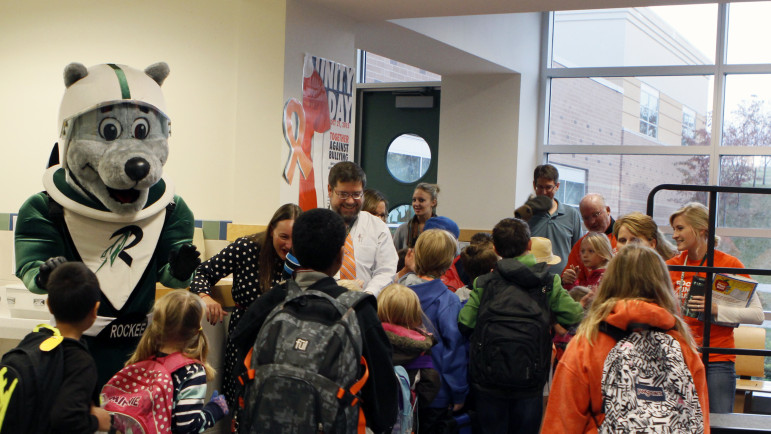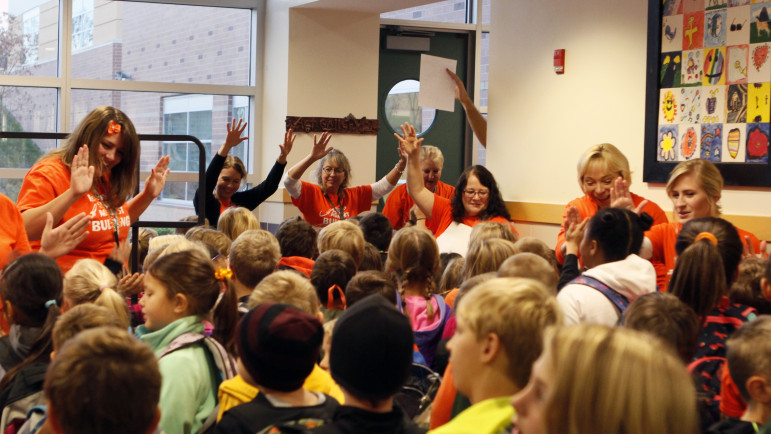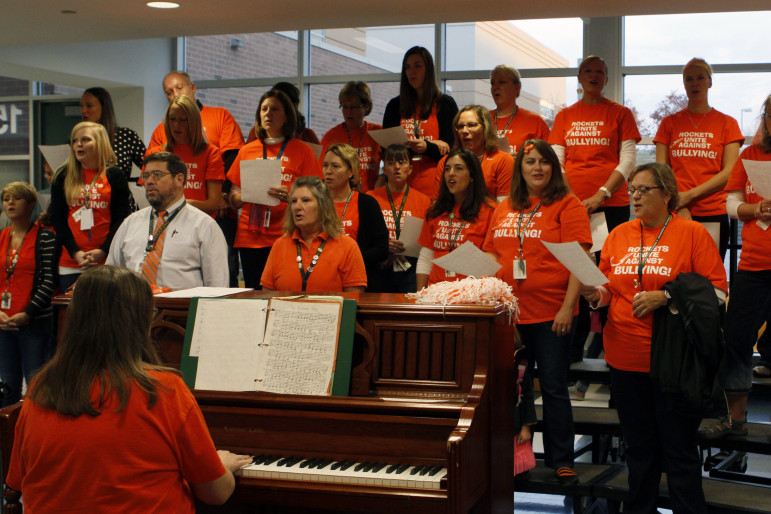This morning at Rockford Elementary Arts Magnet School in Rockford, Minnesota, teachers wearing orange T-shirts that read “Rockford Unites Against Bullying” welcomed a sea of orange-clad students as they filed off the school bus.
They handed out green, white and orange ribbons for the students to attach to their backpacks.
Even the school mascot, a dog called Rockee the Rocket, promised to wear orange.
It’s all part of Unity Day, a nationwide effort sponsored by PACER Center (Parent Advocacy Coalition for Educational Rights) that aims to bring schools and communities together to show solidarity and raise awareness about bullying.
And there’s a reason for all the orange.
“When you see a whole school wearing an orange Unity Day T-shirt, it’s a conversation starter,” said Julie Hertzog, director of PACER’s National Bullying Prevention Center.
“We didn’t really realize how big of an impact [Unity Day] was going to have until we did it,” Rockford school counselor Melissa Spicer said of the school’s inaugural Unity Day last year. “It helps us generate conversations with [students] about what it means to stand up and speak up, and reach out and be a friend.”
Unity Day, established in 2011, is the centerpiece of PACER’s National Bullying Prevention Month, which grew from a single week in 2006 to an entire month in 2010. The day was created as a way to “visibly show solidarity” around bullying prevention and to get communities involved beyond just schools and parents, Hertzog said.
[Related: Lights On Afterschool Celebrations Recognize Programs Big and Small]
Nationwide, 28 percent of students in grades six through 12 reported being bullied in 2011, according to the School Crime Supplement issued in 2013 by the National Center for Education Statistics and Bureau of Justice Statistics.
Kids who are bullied are more likely to experience depression and anxiety, health complaints and decreased academic achievement, according to stopbullying.gov. They also often feel isolated and alone, Hertzog said. Unity Day aims to give them the inspiration to speak up.
“It’s a lot easier to do that when you’ve got a whole movement behind you,” she said.
Elizabeth McGlynn, executive director of Girls on the Run of Montgomery County, Maryland, an after-school running program, said bullying prevention needs to be a year-round practice in both schools and after-school programs like hers.
“Anytime you do something for a day, it’s great … but I definitely think [bullying prevention] has got to be woven more into the everyday vernacular,” McGlynn said of Unity Day. “We want to [work on bullying prevention] every day. We really want the girls to know that this is something you have to practice.”
In the after-school environment, bullying prevention strategies are the same as in the school environment, said Shileste Overton-Morris, senior program development and organizational manager for the Center for Schools and Communities. But they might be implemented differently.
“I think there are more opportunities for kids in after-school programs, as far as bullying prevention is concerned, for teachers to kind of make teachable moments during activities,” Overton-Morris said. In the after-school setting, teachers are more able to work with students on a social-emotional level, she said.
Hearing a different set of role models reinforce the same lessons learned during school is another benefit of after-school programs when it comes to bullying prevention, McGlynn said.
Overton-Morris said media coverage of bullying tends to focus on the details of a bullying itself rather than strategies to address the problem. Bullying Prevention Month and Unity Day are opportunities for people to take a step back and examine the issue of bullying from a broader perspective, she said.
“When you have a month like this where people can become more aware of the subject in a way where there’s less heightened urgency … people are able to digest it in a much different way,” she said.
Hertzog said it’s not easy to measure the impact of Unity Day, but PACER has taken some steps to try to quantify its success. PACER offers posters to order and display. Last year, they sold 6,500 in two weeks, Hertzog said, and this year they distributed close to 9,000.
Other evidence of success has been anecdotal. Hertzog said 15,000 students donned orange Unity Day T-shirts in one Illinois school district. At another school, students spelled out the word “United” on a football field. Cafeterias and local bakeries handed out orange cookies. A florist gave out orange roses to people wearing orange.
It’s all part of an effort to get people talking about bullying, Hertzog said.
“The more you’re talking about this issue, the more kids feel supported about it,” she said.
More related articles:
Two Fields Come Together in New Center for After-school and Summer Enrichment
California Curbs Overuse of Psychiatric Meds on Foster Children
Tough Love: Documentary Shows Parents’ Struggles in Child Welfare Systems

































